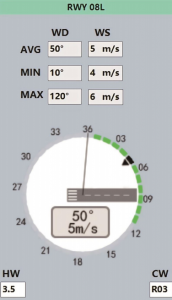BHZG01 Aviation Automatic weather observation System.
The weather view displays the instantaneous and average values of meteorological parameters in digital and chart format. The meteorological elements displayed on the screen are set according to the recommendations of ICAO. The software configures the screen layout and preferred display based on a large number of user habit surveys. In the process of data processing, the landing direction on the runway can be taken into account in the weather view, and the reporting sequence of the meteorological observation field can be adjusted accordingly.
For example, in the wind disk of the right weather view, not only the average and maximum values of wind force and wind direction are presented, but also the headwind and crosswind levels are reported from the pilot’s perspective, providing an intuitive and accurate basis for the pilot’s take-off and landing operation.
In the figure below, black numbers indicate that the RVR is normal, red data indicates that the RVR data is abnormal, brown indicates that the RVR data is not updated, red down arrow indicates that the RVR decreases, and green up arrow indicates that the runway visual range increases. Alarm function is also provided in the weather view. In case of failure of important equipment and sensors, the corresponding data frame will turn red and flash warning. After the alarm is removed, it will stop flashing; When a sensor or device needs maintenance, the relevant data frame will turn orange and pop up a window to remind.

BHZG01 aviation automatic weather observation system provides aviation meteorological decision-making basis for ATC and pilots. The following automatic weather observation functions can be selected according to user needs:
- visibility and RVR
- Cloud height
- Temperature and humidity
- Air pressure
- Wind speed and direction
- precipitation
BHZG01 aviation automatic weather observation system supports mainstream communication standards and practices, and supports the information exchange method currently defined by ICAO. Its system architecture ensures the smooth integration of meteorological data into any existing air traffic control, airport service and maintenance system and other meteorological systems. Seamless integration means that you can continue to use the technology you have invested in to save time, money and energy.


